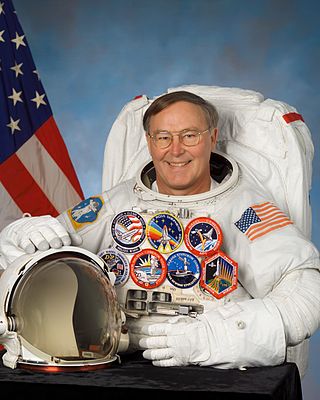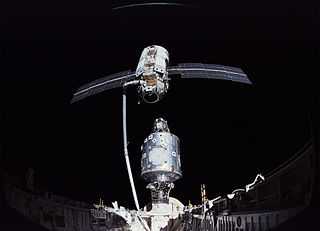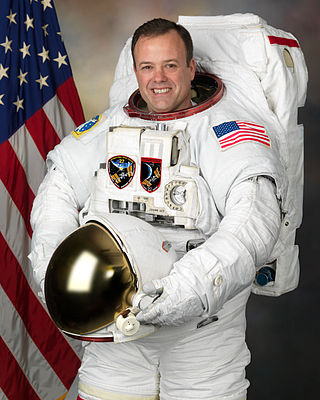
Francis Richard Scobee was an American pilot, engineer, and astronaut. He was killed while commanding the Space Shuttle Challenger in 1986, which suffered catastrophic booster failure during launch of the STS-51-L mission.

John Howard Casper is a former American astronaut and retired United States Air Force pilot.

Eileen Marie Collins is a retired NASA astronaut and United States Air Force (USAF) colonel. A former flight instructor and test pilot, Collins was the first woman to pilot the Space Shuttle and the first to command a Space Shuttle mission.

Jerry Lynn Ross is a retired United States Air Force officer, engineer, and a former NASA astronaut. Ross is a veteran of 7 Space Shuttle missions, making him the joint record holder for most spaceflights.

Richard Michael Mullane is an engineer and weapon systems officer, a retired USAF officer, and a former NASA astronaut. During his career, he flew as a mission specialist on STS-41-D, STS-27, and STS-36.

Karol Joseph "Bo" Bobko was an American aerospace engineer, U.S. Air Force officer, test pilot, and a USAF and NASA astronaut. Bobko was the first graduate of the U.S. Air Force Academy to travel in space and the first person to fly on a space shuttle on three different missions: STS-6, STS-51-D, STS-51-J.

Richard Oswalt Covey is a retired United States Air Force officer, former NASA astronaut, and a member of the United States Astronaut Hall of Fame.

Kent Vernon "Rommel" Rominger is an American former astronaut, former NASA Chief of the Astronaut Office at Johnson Space Center, and a captain in the United States Navy. Rominger holds the Space Shuttle Orbiter flight time record with 1610 hours. He joined ATK Launch Systems Group in 2006 as Vice President of Advanced Programs.

STS-88 was the first Space Shuttle mission to the International Space Station (ISS). It was flown by Space Shuttle Endeavour, and took the first American module, the Unity node, to the station.

Brian Duffy is a retired U.S. Air Force colonel and a former NASA astronaut. He flew aboard four Space Shuttle missions.

Ronald John Grabe, , is a former NASA astronaut.

Sidney McNeill "Sid" Gutierrez, is an American pilot and former NASA astronaut. Since retiring from NASA, Gutierrez has worked in several leadership positions at Sandia National Laboratories and Rocket Crafters Inc.

Lloyd Blaine Hammond Jr. is a Gulfstream test pilot, a former United States Air Force officer, and a former NASA astronaut. He flew on two Space Shuttle missions.

Steven Wayne Lindsey is a retired U.S. Air Force officer and NASA astronaut. Lindsey served as Chief of the NASA Astronaut Office from September 2006 until October 2009.

The Manned Orbiting Laboratory (MOL) was part of the United States Air Force (USAF) human spaceflight program in the 1960s. The project was developed from early USAF concepts of crewed space stations as reconnaissance satellites, and was a successor to the canceled Boeing X-20 Dyna-Soar military reconnaissance space plane. Plans for the MOL evolved into a single-use laboratory, for which crews would be launched on 30-day missions, and return to Earth using a Gemini B spacecraft derived from NASA's Gemini spacecraft and launched with the laboratory.

Carl Joseph Meade is a former NASA astronaut.

Steven Ray Nagel, , was an American astronaut, aeronautical and mechanical engineer, test pilot, and a United States Air Force pilot. In total, he logged 723 hours in space. After NASA, he worked at the University of Missouri College of Engineering as an instructor in its Mechanical and Aerospace Engineering Department.
Criticism of the Space Shuttle program stemmed from claims that NASA's Space Shuttle program failed to achieve its promised cost and utility goals, as well as design, cost, management, and safety issues. Fundamentally, it failed in the goal of reducing the cost of space access. Space Shuttle incremental per-pound launch costs ultimately turned out to be considerably higher than those of expendable launchers. In 2010, the incremental cost per flight of the Space Shuttle was $409 million, or $14,186 per kilogram to low Earth orbit (LEO). In contrast, the comparable Proton launch vehicle cost was $141 million, or $6,721 per kilogram to LEO and the Soyuz 2.1 was $55 million, or $6,665 per kilogram, despite these launch vehicles not being reusable.

Ronald John Garan Jr. is a retired NASA astronaut. After graduating from State University of New York College at Oneonta in 1982, he joined the Air Force, becoming a Second Lieutenant in 1984. He became an F-16 pilot, and flew combat missions in Desert Shield and Desert Storm. Before becoming an astronaut he was the Operations Officer of the 40th Flight Test Squadron (FTS). He first flew in space as a mission specialist on the May 2008 STS-124 mission to the International Space Station (ISS). He returned to ISS on April 4, 2011, for a six-month stay as a member of Expedition 27. Garan is a highly decorated former NASA astronaut who flew on the US Space Shuttle, Russian Soyuz, and International Space Station. In total he spent 178 days in space and more than 71 million miles in 2,842 orbits of Earth, 27 hours and 3 minutes of EVA in four spacewalks, and 18 days on the bottom of the ocean during the NEEMO-9 undersea mission.

Shuttle-Centaur was a version of the Centaur upper stage rocket designed to be carried aloft inside the Space Shuttle and used to launch satellites into high Earth orbits or probes into deep space. Two variants were developed: Centaur G-Prime, which was planned to launch the Galileo and Ulysses robotic probes to Jupiter, and Centaur G, a shortened version planned for use with United States Department of Defense Milstar satellites and the Magellan Venus probe. The powerful Centaur upper stage allowed for heavier deep space probes, and for them to reach Jupiter sooner, prolonging the operational life of the spacecraft. However, neither variant ever flew on a Shuttle. Support for the project came from the United States Air Force (USAF) and the National Reconnaissance Office, which asserted that its classified satellites required the power of Centaur. The USAF agreed to pay half the design and development costs of Centaur G, and the National Aeronautics and Space Administration (NASA) paid the other half.




















